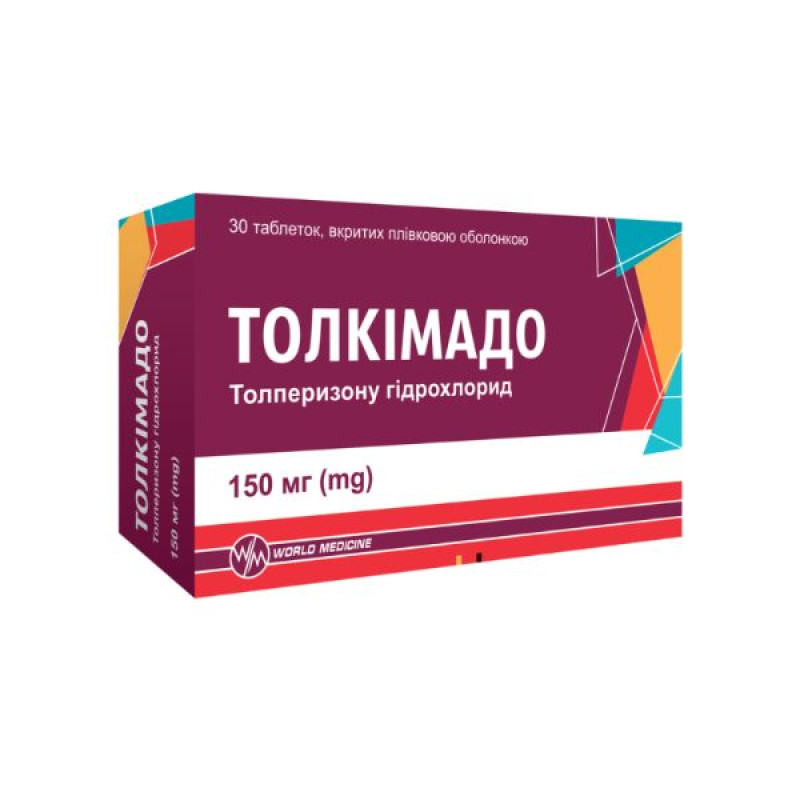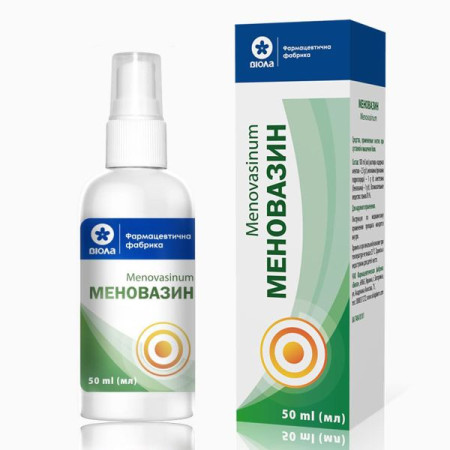Tolkimado tablets 150 mg No. 30

Instructions for Tolkimado tablets 150 mg No. 30
Composition
active ingredient: tolperisone hydrochloride;
1 film-coated tablet contains 150 mg of tolperisone hydrochloride;
excipients: citric acid, monohydrate; microcrystalline cellulose; lactose, monohydrate; corn starch; colloidal anhydrous silicon dioxide; talc; stearic acid;
film coating: Opadry® white 03F180011 (hypromellose, titanium dioxide (E 171), macrogol).
Dosage form
Film-coated tablets.
Main physicochemical properties: round biconvex tablets, film-coated, white to off-white, engraved with “T150” on one side.
Pharmacotherapeutic group
Muscle relaxants with a central mechanism of action. ATC code M0ZV X04.
Pharmacological properties
Pharmacodynamics.
Mechanism of action.
Tolperisone is a centrally acting muscle relaxant. Its mechanism of action is not yet fully understood.
Tolperisone has a high affinity for nervous tissue, reaching the highest concentrations in the brainstem, spinal cord, and peripheral nervous system.
The most significant effect of tolperisone is its inhibitory effect on the spinal reflex pathway. Presumably, this effect, together with the inhibitory effect on the descending pathways, determines the therapeutic benefit of tolperisone.
The chemical structure of tolperisone is similar to that of lidocaine. Like lidocaine, it has a membrane-stabilizing effect and reduces the electrical excitability of motor neurons and primary afferent fibers. Tolperisone dose-dependently inhibits the activity of voltage-gated sodium channels. Accordingly, the amplitude and frequency of the action potential are reduced.
It has been shown to have an inhibitory effect on voltage-gated calcium channels. It is assumed that in addition to its membrane-stabilizing effect, tolperisone may also inhibit mediator release.
To top it all off, tolperisone has some weak alpha-adrenergic antagonist properties and exerts antimuscarinic effects.
Clinical efficacy and safety.
The effectiveness of tolperisone in the treatment of muscle spasm after a stroke has been proven.
In a randomized, double-blind, placebo-controlled trial of 120 patients with post-stroke muscle spasm, tolperisone treatment resulted in a highly significant reduction in the primary endpoint of spasticity on the Ashworth scale. Tolperisone was superior to placebo in the overall physician and investigator efficacy assessment (p < 0.001). The mean improvement on the Ashworth scale was 32% in the overall intention-to-treat (ITT) population and 42% in the subgroup of patients receiving tolperisone 300–450 mg/day. Tolperisone was also superior to placebo in functional tests, but the differences were not statistically significant.
In a randomized, double-blind, comparative study of 48 patients with brain injury, the efficacy of tolperisone on the Barthel index was comparable to that of baclofen. At the same time, tolperisone was superior to baclofen in improving the Rivermead Motor Assessment Scale (RMAS).
The evidence for the efficacy of tolperisone in treating increased muscle tone in patients with musculoskeletal conditions other than post-stroke muscle spasm is conflicting. Some studies have reported positive results on some tests, while others have failed to show any benefit of tolperisone in these conditions.
The safety profile of tolperisone is based on data from clinical studies involving patients with increased muscle tone of various etiologies, as well as on data from spontaneous reports of adverse reactions.
Pharmacokinetics.
Absorption.
When administered orally, tolperisone is well absorbed in the small intestine. The maximum concentration in the blood plasma is reached 0.5-1.5 hours after administration. Due to the significant first-pass metabolism, the bioavailability of tolperisone is approximately 20%. Fatty food increases the bioavailability after oral administration by approximately 100%, and the maximum concentration in the blood plasma by approximately 45% compared to administration on an empty stomach. The time to reach the maximum concentration is increased by approximately 30 minutes.
Metabolism.
Tolperisone is extensively metabolized by the liver and kidneys. It is almost completely excreted by the kidneys (more than 99%) in the form of metabolites. The pharmacological activity of the metabolites is unknown.
Breeding.
The half-life of tolperisone after intravenous administration is about 1.5 hours, after oral administration - about 2.5 hours.
Preclinical safety data.
Based on non-clinical data on safety pharmacology, repeated dose toxicity, genotoxicity, and toxicity to reproduction, no specific risk to humans was identified.
Embryotoxic changes were observed in rats and rabbits after oral administration of tolperazone at doses of 500 mg/kg body weight and 250 mg/kg body weight, respectively. However, these doses are many times higher than the recommended therapeutic dose for humans.
Indication
Symptomatic treatment of muscle spasm in adults after stroke.
Contraindication
Hypersensitivity to tolperisone, its chemically similar eperisone and/or to other excipients of the drug.
Myasthenia gravis.
Breastfeeding period.
Interaction with other medicinal products and other types of interactions
Pharmacokinetic studies of drug interactions with dextromethorphan, a CYP2D6 substrate, have demonstrated that concomitant use of tolperisone increases plasma concentrations of drugs that are predominantly metabolized by cytochrome CYP2D6, in particular concentrations of thioridazine, tolterodine, venlafaxine, atomoxetine, desipramine, dextromethorphan, metoprolol, nebivolol, perphenazine.
In vitro studies in human liver microsomes and hepatocytes did not reveal significant inhibition or induction of other CYP isoenzymes (CYP2B6, CYP2C8, CYP2C9, CYP2C19, CYP1A2, CYP3A4).
It is expected that with simultaneous use with other CYP2D6 substrates and/or other agents, exposure to tolperisone will not increase, which is due to the diversity of tolperisone metabolic pathways.
When taking tolperisone on an empty stomach, its bioavailability is reduced, therefore, when using the drug, it is recommended to take into account the connection with food intake.
Although tolperisone is a centrally acting agent, the likelihood of developing a sedative effect when used is low. In the case of simultaneous use with other centrally acting muscle relaxants, it is necessary to consider the issue of reducing the dose of tolperisone.
Tolperisone potentiates the effects of niflumic acid, therefore, when used simultaneously, the dose of niflumic acid, as well as other NSAIDs, should be reduced.
Application features
Risk of hypersensitivity reactions.
In the post-marketing period, the most frequently observed adverse reactions with tolperisone were hypersensitivity reactions. Their severity ranged from mild skin reactions to severe systemic reactions, including anaphylactic shock. Symptoms of hypersensitivity reactions may include erythema, rash, urticaria, pruritus, angioedema, tachycardia, hypotension or dyspnoea.
Women with a history of hypersensitivity to other drugs or allergic conditions are at higher risk of hypersensitivity reactions when taking tolperisone.
Patients should be advised to be vigilant for possible symptoms of allergy while taking the drug. Patients should be informed that if symptoms of allergy occur, they should stop taking tolperisone and seek medical attention immediately.
In the event of an episode of hypersensitivity to tolperisone, the drug should not be re-administered.
Excipients precautions.
The medicinal product contains lactose and should not be administered to patients with rare hereditary forms of galactose intolerance, the Lapp lactase deficiency or glucose-galactose malabsorption syndrome.
Use during pregnancy or breastfeeding
According to animal studies, tolperisone does not have a teratogenic effect.
Due to the lack of significant clinical data, the drug should not be used during pregnancy.
Since it is not known whether tolperisone passes into breast milk, the use of the drug during breastfeeding is contraindicated.
Ability to influence reaction speed when driving vehicles or other mechanisms
Given the possibility of developing symptoms such as dizziness, drowsiness, impaired attention, epilepsy, blurred vision, the drug should be used with caution when driving or operating other mechanisms.
Method of administration and doses
The medicine is intended for oral use.
The tablets should be taken after meals with 1 glass of water. Insufficient food intake may reduce the bioavailability of tolperisone.
Adults.
The drug should be used depending on individual need and tolerability at a dose of 150-450 mg (in 3 doses) per day.
Patients with impaired renal function.
Experience with tolperazon in patients with renal impairment is limited, and a higher incidence of adverse reactions has been reported in such patients. Therefore, in moderate renal impairment, individual dose titration with careful monitoring of the patient's condition and renal function is recommended. In severe renal impairment, the drug is not recommended.
Patients with liver dysfunction.
Experience with tolperazon in patients with liver damage is limited, and a higher incidence of adverse reactions has been reported in such patients. Therefore, in moderate liver damage, individual dose titration with careful monitoring of the patient's condition and liver function is recommended. In severe liver damage, the drug is not recommended.
Children
The safety and effectiveness of tolperisone in children have not been studied.
Overdose
Data on overdose of tolperisone are insufficient.
Symptoms of overdose may mainly include drowsiness, gastrointestinal symptoms (nausea, vomiting, epigastric pain), tachycardia, hypertension, bradykinesia and vertigo. In severe cases, convulsions, respiratory depression, apnea and coma have been reported.
In case of overdose, symptomatic treatment is recommended. There is no specific antidote for tolperisone.
Side effects
During the use of tolperazon, the most common adverse reactions were skin and subcutaneous tissue disorders, systemic disorders, and disorders of the nervous and digestive systems.
According to post-marketing surveillance, approximately 50-60% of adverse reactions associated with tolperisone are hypersensitivity reactions. Most of these reactions were minor and self-limiting. Life-threatening hypersensitivity reactions have occurred in isolated cases.
Adverse reactions are listed by system organ class according to the MedDRA Medical Dictionary of Regulatory Activities using the following MedDRA frequency definitions: uncommon (≥ 1/1000, < 1/100), rare (≥ 1/10,000, < 1/1000), very rare (< 1/10,000), not known (frequency cannot be estimated from the available data).
From the blood and lymphatic system:
very rarely - anemia, lymphadenopathy.
On the part of the immune system:
Rare: hypersensitivity reaction, anaphylactic reaction; very rare: anaphylactic shock.
Nutritional and metabolic:
uncommon – anorexia; very rare – polydipsia.
From the psyche:
infrequently - insomnia, sleep disorders; rarely - decreased activity, depression; very rarely - confusion.
From the nervous system:
infrequently - headache, dizziness, drowsiness; rarely - disturbance in attention, tremor, convulsions, hypoesthesia, paresthesia, lethargy (increased drowsiness).
On the part of the organs of vision:
rarely - visual impairment.
On the part of the organs of hearing and balance:
rarely - tinnitus, vertigo.
From the heart:
rarely - angina pectoris, tachycardia, palpitations, decreased blood pressure; very rarely - bradycardia.
From the vascular system:
infrequently - hypotension; rarely - skin hyperemia.
On the part of the respiratory system, chest organs and mediastinum:
rarely - difficulty breathing, nosebleeds, rapid breathing.
From the digestive tract:
infrequently - abdominal discomfort, diarrhea, dry mouth, dyspepsia, nausea; rarely - epigastric pain, constipation, flatulence, vomiting.
From the hepatobiliary system:
rarely - mild liver damage.
Skin and subcutaneous tissue disorders:
rarely - allergic dermatitis, hyperhidrosis, itching, urticaria, rash.
Musculoskeletal and connective tissue disorders:
infrequently - muscle weakness, myalgia, pain in the extremities; rarely - feeling of discomfort in the extremities; very rarely - osteopenia.
From the kidneys and urinary tract:
rarely – enuresis, proteinuria.
On the part of the body as a whole and complications at the injection site:
infrequently - asthenia, discomfort, increased fatigue; rarely - a feeling of intoxication, a feeling of heat, irritability, thirst; very rarely - a feeling of discomfort in the chest.
From the laboratory parameters:
rarely - decrease in blood pressure, increase in bilirubin concentration in blood plasma, change in liver enzyme activity, decrease in platelet count, leukocytosis; very rarely - increase in creatinine concentration in blood plasma.
Reporting of suspected adverse reactions.
Reporting suspected adverse reactions that occur after the registration of a medicinal product is very important. This allows for continuous monitoring of the benefit/risk balance of the medicinal product. Healthcare professionals should report any suspected adverse reactions through the national pharmacovigilance system.
Expiration date
3 years.
Storage conditions
Store at a temperature not exceeding 25 °C out of the reach of children.
Packaging
10 tablets in a blister; 3 blisters in a cardboard box.
Vacation category
According to the recipe.
Producer
WORLD MEDICINE ILACH SAN. VE TIJ. A.Sh./WORLD MEDICINE ILAC SAN. VE TIC. AS
Location of the manufacturer and address of its place of business
15 Temmuz Mahallesi Cami Yolu Caddesi No:50 Gunesli Bagcilar/Istanbul, Turkey/15 Temmuz Mahallesi Cami Yolu Caddesi No:50 Gunesli Bagcilar/Istanbul, Turkey.
Applicant
WORLD MEDICINE LLC, Ukraine/WORLD MEDICINE, LLC, Ukraine.
There are no reviews for this product.
There are no reviews for this product, be the first to leave your review.
No questions about this product, be the first and ask your question.

